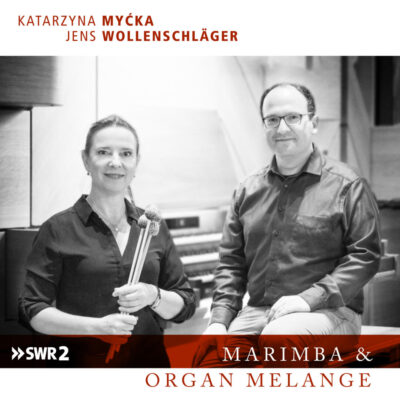Katarzyna Mycka is also known by critics as “the one who dances with mallets”. She has recorded a cross-section of her repertoire on over 10 CDs and commissioned numerous compositions. Perfect touch technique and a dreamlike rhythmic precision are characteristic for her playing on the concert marimba, consisting of 60 narrow wooden plates and resonance tubes made of metal.
Jens Wollenschläger is a professor of organ and vice-rector at the Hochschule für Kirchenmusik in Tübingen (the University of Church Music) and the First Organist of Tübingen Stiftskirche (collegiate church). Raised in Landau, Palatinate, he studied church music (A-exam) in Stuttgart and organ (concert exam with distinction) in Hamburg. He has recorded over 95 CDs and is well-known as a composer, music editor and song accompanist.
Manuela Nägele (*1967)
Come Together
It is exciting how opposites can meet, complement, and play with each other. Encounters occur daily in different contexts, where they can be casual or of great significance and depth.
Counterparts move and challenge at the same time. Being open to engaging with each other can lead to new and unexpected things: Listening to each other is a prerequisite for constructive confrontation, which gives way to an interplay of forces, colours and volume, a give and take, a withdrawing and stepping forward.
All this resonates in the concerto concept – competing, leading and being led, sounding together. Each instrument contributes its diverse tonal possibilities.
Come Together invites others to be their own and rejoice in their difference.
Manuela Nägele
Anna Ignatowicz-Glińska (*1968)
Ślady niepewności / The Traces of Incertitude
Ślady niepewności/The Traces of Incertitude was initially written for harpsichord and organ in 1995. I prepared a new version of the piece for marimba and organ for Katarzyna Myćka in 2013, released by NORSK Musikforlag/Oslo. The musical idea I pursued in this piece was to establish a dialogue between virtuoso instruments stylistically inspired by the aesthetics of the Baroque era. The new version was premiered in Berlin in 2013 and performed by Katarzyna Myćka and Franz Raml.
Jens Wollenschläger (*1976)
schwere los (weight less)
Three Concertante Impressions for Marimba and Organ (2020/22)
In German, the title schwere los (weightless) is intentionally lower-case and written with a space between the two words to stimulate reflection and allow for multiple interpretations. First, it includes weightlessness. However, it also expresses the opposite: Schwere ist los, meaning something heavy and oppressive is present. In German, the full expression “das schwere Los” would be a play on words referring to a hard lot. Indeed, the characters of the individual movements swing back and forth between these extremes.
Jens Wollenschläger
Paul Creston (1906–1985)
Meditation
Meditation for marimba and organ is the second movement of Paul Creston’s Concertino for Marimba, written in 1940 and arranged for this duo by the composer. This particular movement from Creston’s more extensive work is one of the most beautiful and calming pieces of music ever written for the marimba.
Kay Johannsen (*1961)
Entre nous
I have always been fascinated by the sound of the marimba and the almost sporty but certainly dance-like grace with which professional musicians play it. We also had a marimba at home for a few years because my son had taken an interest in the instrument. Therefore, the percussion concerto I wrote for him had to include a separate movement for the marimba. I also used that instrument once for a solo in my organ opera Nachtbus.
Writing a piece in which the organ can be perceived as a real partner of another instrument is challenging. Although the organ has orchestral qualities – in other words, a wide range of timbres – it must be used in a highly disciplined and sparing manner when composing to avoid sounding too overwhelming.
In Entre nous, I have tried to create as many types of dialogue as possible in a rather cheerful “conversational” atmosphere.
Kay Johannsen
Johann Sebastian Bach (1685–1750)
Orchestral Suite No. 2 in B minor BWV 1067
This suite with ouverture and the following concertante dances is one of the great master’s most famous compositions, a prominent work in the repertoire for flute with accompaniment. The delightful badinerie, the last movement, is one of the best-known pieces of music ever: its driving rhythm engages listeners, with its melody swinging in their ears for a long time.
The various movements of this Bach orchestral suite act as cheerful intermezzi in our Mélange. Whereas in the original Baroque instrumentation, continuo, string section and virtuoso solo flute are placed opposite each other, the organ and the marimba can now play out their different characters, compete with and complement each other: stability and immediacy of sound on the one hand, percussive-dancing lightness and accentuation on the other.

